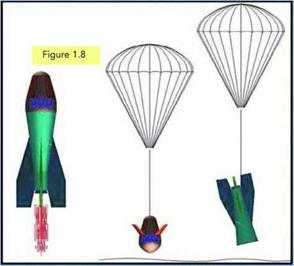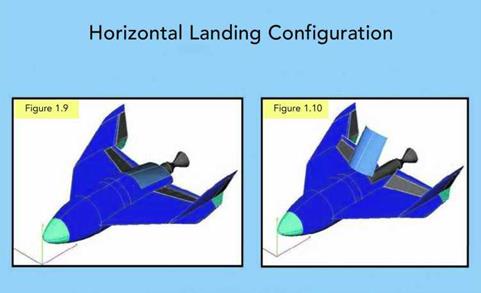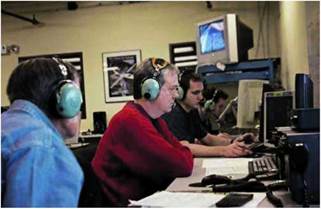Paul Allen
Up to this point, design and development had been relegated to computer analysis and foam models. Burt Rutan hadn’t been ready to approach anyone for funding until he felt ready that he could deliver what he’d promised. Figure 1.12 shows Rutan and aerodynamicist Jim Tighe during early computer analysis.
For the design of SpaceShipOne and White Knight, Scaled Composites would rely heavily on computer analysis because the vehicles would not go through wind-tunnel testing. Figure 1.13 shows an evaluation of SpaceShipOne as the tail booms bend downward.
Around this time, Rutan and philanthropist Paul Allen, who cofounded Microsoft in 1975 with his high school friend Bill Gates, had begun exploring the possibility of using high-altitude airplanes circling over Fos Angeles as a way to provide broadband wireless to the city. “My first couple of meetings with Paul were not about space at all,” recalled Rutan. “There was an interest that he had in something else I was doing. It was related to Proteus for telecommunications.” They eventually got around to talking about space, and Rutan’s idea for a very low-cost suborbital spacecraft. Allen turned out to be a bit of a space enthusiast and became quite interested. But Rutan was still not comfortable with his design, which was still based upon a capsule and parachutes at the time.
Once fiber optics took off, using an airborne telecommunications platform was no longer feasible, but Rutan hadn’t stopped thinking about the spaceship. “I figured out the ‘carefree’ reentry, and I thought I could have something that could land as a glider, be more operable, and a lot safer. I didn’t know that ‘carefree’ reentry would work. I just had a good feeling about it.”
In the spring of 2000, Rutan felt he was ready for funding. “I actually asked for a meeting with Paul. And I said, ‘Fisten, I think
|
|
Г Л
Fig. 1.5. The first engineer that Burt Rutan hired at Scaled Composites,
Doug Shane, was responsible for the flight testing of SpaceShipOne and White Knight. During the flight tests, Shane’s was the cool, calm voice on the Mission Control side of the radio. Mojave Aerospace Ventures LLC, photograph by David M. Moore
V_____________________________ )
г л
Fig 1.6. Before the design of SpaceShipOne was conceived, Burt Rutan developed a concept for a single-seat rocket to be launched into space off of Proteus, a high-altitude research aircraft.
Fig. 1.7. As Proteus reached launch altitude, it would perform a zoom maneuver by pointing up at a steep angle to assist the trajectory of the rocket on its suborbital flight. Mojave Aerospace Ventures LLC, provided courtesy of Scaled Composites
V____________________________ )
I could do this now.’ And he put out his hand and shook it and said, ‘Let’s do it.’”
Like many kids growing up in the late 1950s and 1960s, Allen remembered the television cart being wheeled into his classroom to watch Mercury, Gemini, and Apollo launches. Science and technology had fascinated him whether he was building model rockets or reading science fiction. “I always had in the back of my mind, would I ever have the opportunity to do something in a space-related initiative?” Allen recalled. “And so when the SpaceShipOne opportunity came up, I was very excited to pursue it.”
Paul Allen’s company, Vulcan, Inc., and Scaled Composites began a partnership called Mojave Aerospace Ventures. Although Allen and Rutan were aware at the time of the creation of the X Prize by Peter
Diamandis, their initial goal, however, was getting to space and not necessarily winning the X Prize.
“None of these meetings were about the X Prize,” Rutan said. “People think we did the program for the X Prize. But keep in mind, the X Prize wasn’t even funded until halfway through our program. And, in fact, I had an opinion that Peter Diamandis would never get the funds for it. So, we had written him off.”
By the time the partnership was finalized a few months into 2001 and Allen provided the funding to Rutan, winning the X Prize had also become a goal of Mojave Aerospace Ventures. “There were two ways for me to recoup my investment,” Allen said. “One was the winning of the X Prize, and one was the licensing we’d be able to achieve with a company like Virgin Galactic. Those were the possible
![]()
 Ґ ^
Ґ ^
Fig. 1.8. After completing the boost, the capsule separated from the booster. It is here where Burt Rutan first applied the idea of a feathered,
"carefree" reentry. Small arms pointing upward from the capsule would safely decelerate and steady the capsule during reentry. Mojave Aerospace Ventures LLC, provided courtesy of Scaled Composites
V___________________ )
ґ ^
 Fig. 1.9. Because of Burt Rutan’s decades of experience designing aircraft, he decided to abandon the idea of a rocket and parachutes.
Fig. 1.9. Because of Burt Rutan’s decades of experience designing aircraft, he decided to abandon the idea of a rocket and parachutes.
His next designs focused on winged aircraft that could make horizontal landings on a runway.
Fig. 1.10. Still called a feather, early winged designs used large spoilers and elevons for reentry. Below the speed of sound this configuration worked. However, reentry occurred above Mach 1, and these configurations could not be controlled. Mojave Aerospace Ventures LLC, provided courtesy of Scaled Composites
к J
future mechanism of payment back when we were evaluating all this stuff. You didn’t necessarily assume you were going to win. And you didn’t know what the other competition was like.”
Now things started to move full speed ahead.











